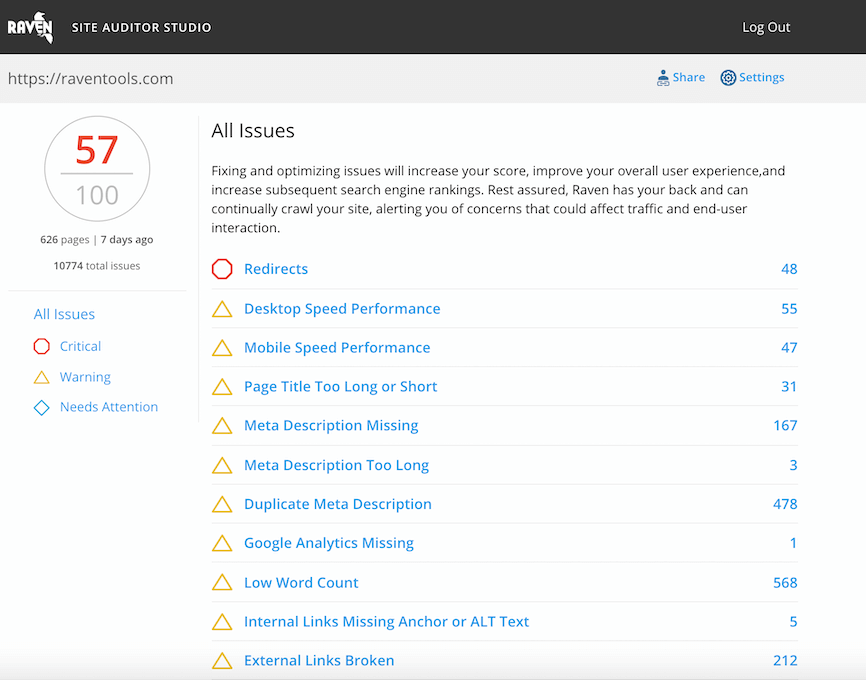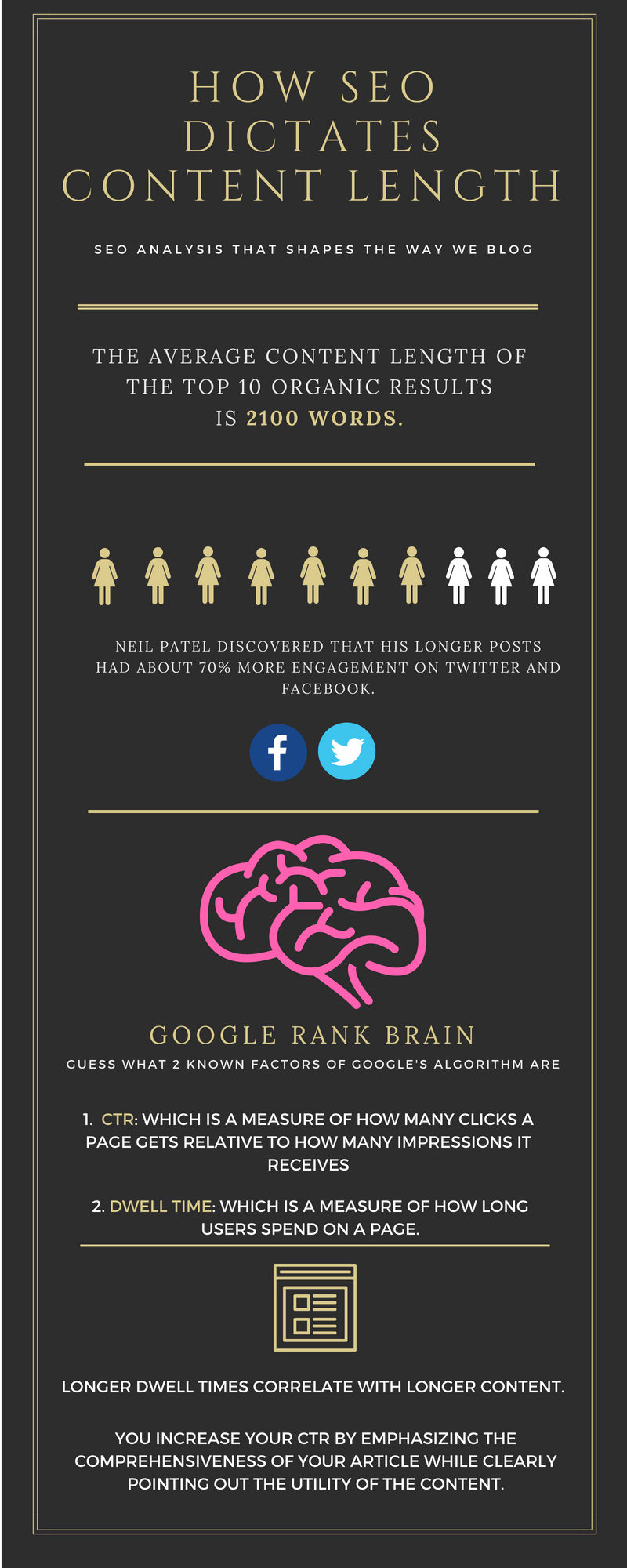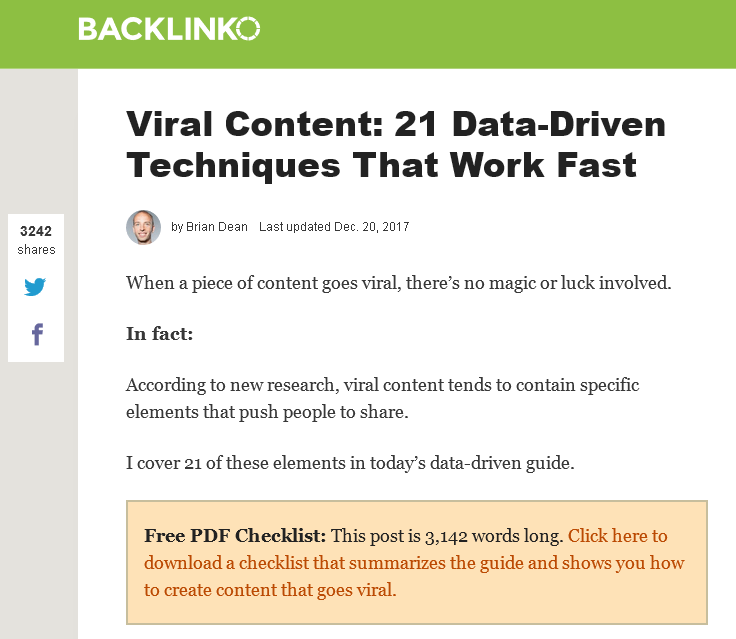Perhaps the most talked about topic in SEO, “content methodology”. Every optimizer has their opinion on what makes great SEO content, and we’re no different. But what does the data say about content length and what can we learn by applying a little logic?
By now you’ve probably seen the statistics: the Web is full of advice to create long-form content.
Long form content seemingly performs better in search and on social media according to correlation studies.
On the other hand, you could publish 10 short posts in the same time you write one huge essay. Also sometimes a short message is enough.
Consider this example: “f* you!” (Sorry for being rude but I hope you got the point!)
It does not make sense to artificially inflate the word count for some types of messages. “The Ultimate Guide to F***ing You” won’t work better.
It’s a bit like saying that the higher the building the better. A building’s height does not speak towards the value of what exists within the building. Of course, you could argue that a skyscraper stands out, but does that logic always apply?
How Should You Be Measuring Your Content’s Length?
What is content length or size in the first place?
- Do we really mean the sheer number of words?
- What about images, videos etc.?
- Do we mean pixels we have to scroll to see all of it?
Content length is probably best measured as the time spent on consuming the content. Of course, publishers want you to spend as much time as possible on their sites.
The longer you stay on site the better for the site owner?
Remember? Facebook made the by now infamous algorithm changes to penalize viral content by strangers – that is publishers in plain English. They now favor friends and family again.
Mark Zuckerberg even bragged that people spend less time on Facebook in a bizarre twist of events. Usually a typical success metric was the actual time spend on the site per day – in hours.
Content Length as a Time Metric
Some publications will tell you upfront how long it takes to read a particular post. It’s an estimate but it is often reassuring that you don’t waste your time.
Podcasts and videos display their length beforehand as well so that you know how much time you need to invest before even starting to listen or watch. Here’s an example from The Guardian:
Personally I rarely watch hour-long videos because I have work to do and try to limit my screen time for both health and mental-health reasons.
I also rarely listen to podcasts. It’s not just about making time. I simply do not want to wait until they actually tell what I want to know after
- greeting everybody
- introducing the sponsors
- explaining the context.
When it comes to text I actually skip to the relevant sentences or paragraphs skimming most of it. I’m not they only one.
Usability studies have shown that Internet users don’t read body text from start to end.
Most people just read the headline and then decide to leave immediately or try the first paragraph.
Of those who stay with you after the headline only a tiny minority will read the entire post word by word.
Despite all of these findings the generally accepted advice is that long-form content is the best option to rank on Google and thus gain an audience for your content in the first place.
Why Does Long-form Content Seem to Work?
It’s works something like this: people notice that it’s huge, are awed and then recommend the content to their peers without really digesting it as a whole.
In a group interview on whether long-form content still works on Google this year – or whether it’s rather something else by now – I said the following:
“Let my clarify first that I was never convinced that it is sheer content length or size that leads to higher rankings despite the numerous correlation studies.
I know the guy who started the incredibly long content trend. It was Brian Dean of Backlinko.com!
He still ranks top 3 for [link building] on Google as seen from Berlin, Germany where we both live. It must still work then. Is it only the length that made him succeed? Hardly! (…)
In case it’s really the length it’s probably the length in hours he invested into that particular piece of content.
Brian Dean has been the first person to work 60, 80 or 100h on a single article to make it the size of a truly ultimate guide. Brian spends most time on
- research
- outreach
- planning.
This is the approach that still makes sense for Google and beyond.”
End of quote. I went on explaining what it exactly is that works instead of just the length. Let me elaborate on what it really means.
Long-form Noise vs Short-Form Signal
You can write 2.000 words of fluff and you can write 200 words of densely packed signal. You can use incredibly complex sentences and use dozes of examples just to confuse people.
They may stay longer to get the gist but they will be less likely to return next time. Brian Dean is successful not just because he ranks well on Google. He does not trap searchers.
Brian over-delivers what he promised. He might provide dozens of examples or techniques but they are not redundant. It’s the depth or value of his content that matters. People return then.
- Beginners
- intermediate users
- experts
alike can learn something from Backlinko. Even me – someone who has spent 15+ years on optimizing websites – can get fresh, deep or valuable insights:
Also please take note that Brian warns his readers that his post has 3,142 words and offers a PDF checklist that summarizes it.
Other – less humble experts – often get angry at Brian for outranking their pseudo-scientific advice with his popularizations of common search engine optimization topics.
Even in Backlinko’s case it’s not the sheer length you could argue then. It the wide range of audiences he reaches. It’s also the controversy when disgruntled experts express their envy.
Btw. I almost forgot: here is the study from 2016 that started the long-form trend to a large extent. Of course Brian was already living proof by then.
Huge Content That Nobody Knows About Is A Fail
On the Web any publicity is good publicity. The current US president used this motto to become popular online. His most ardent opponents still spread his message by vehemently disagreeing.
When it comes to Backlinko’s popularity provocation is just one among many – a minor – part of the success recipe – be it written or filmed.
Both the text and video pieces are highly optimized and spread due to upfront outreach efforts. Brian was the first person to contact people before the actual content was live.
You can feature other people in your works and thus get their endorsements or at least mentions and shares on social media.
Don’t be afraid to make “your competitors for attention” the stars of your content. As a content creator you are a coach. Influencers are your most valuable players.
It’s a team effort though. The more people you involve before actually going live and the more they anticipate your publication the better.
This can work independently of content size. When you manage to put 20 experts into 200 words you will get a similar number of shares as with 2.000!
The size of your
- audience
- community
- tribe
matters much more than the word count or time needed to view the content. Promote other people to get promoted. Reciprocity is how the social in social media works.
When you praise them they may even link to you to show off the praise. You do not even have to fake it. Just be genuine and grateful.
I asked my following on Twitter what the ideal content length is and I got very different responses. Yet all of them are right in some sense.
They cover most of the important points in the short vs long debate. While length seems to have some impact it’s not the best content quality metric. Check them out:
Zack Neary Hayes, freelance SEO consultant from Leeds, UK responded that “there is no ideal length“:
Long enough so that it answers the query to the best possible standard. If that takes 100 or 10,000 words, so be it. There is no ideal length. Longer content isn’t automatically good because it’s longer. It *can* be good if it’s deep and thorough.
— Zack Neary-Hayes (@NH_Zack) February 2, 2018
Ragil Pembayun, independent York/Leeds, UK based technical SEO agrees and adds that “length isn’t a good indicator“:
On a more serious note, Jack hits the nail on the head though. Length isn’t a good indicator; if the content answers a query then it’s a good content even if it’s short. if it’s open-ended then how long is a piece of string?
— Ragil Pembayun (@RagilPembayun) February 2, 2018
Malaika Nicholas, content marketer at Ladder Digital reflects the popular opinion that “content with +2,000 words ranks higher in search engines“:
Generally, content with +2,000 words ranks higher in search engines, but you can’t go wrong with well-written content with 800-1500 words.
— Princess Shuri (@Asa_Lama_Laika) February 2, 2018
David Iwanow, global SEO manager at Schibsted Media Group argues that “300-500 words… [are] enough” or “people won’t bother to read it as it’s too long“:
300-500 words… enough that can cover a topic without going on and on and on and on and on…. and mostly not so much that people won’t bother to read it as it’s too long
— David Iwanow (@davidiwanow) February 2, 2018
What’s Your Message Then?
As initially stated it depends on the message how long the content should be. A short message does not need 2k words or 20 minutes of explanation.
When you look at so-called long-form content you can see that many of the larger content pieces do not need such a length. How do you know?
Let me translate some typical headline example into what they truly mean or what the underlying message is. You can judge yourself.
Here are some examples I have seen in the wild in a very similar manner. Some of them have worked in the past, guess which ones:
- “how we built 666 links in 6 days [case study]” = we rock: here’s proof
- “33 questions to ask yourself before publishing a blog post” = blogging is difficult – don’t even try it
- “101 ways to make money online” = it’s hard to find a business model, there are too many options.
Please note that the reader does not need such content. None of these headlines and articles are really useful. Why?
The first post is far too self-promotional. You can see how they did it but you are not likely to learn how do it yourself. They’re mostly bragging.
Yet you could just slightly change it to make it really useful. Consider this variation:
“How to build 666 links in 6 days [step by step guide]”
Now provide the actual “how to” steps! In this case, a long article or video makes sense as you provide a detailed and easy to follow explanation.
The second headline makes a mistake I have made myself in the past here and there. Just because you make a list doesn’t mean it’s useful.
When you are actually adding a burden to the reader and trying to prevent people from acting by making readers overtly cautious you are actually doing more harm than good.
Guess what – such “cautionary tales” posts don’t work no matter how long they are! When you offer discouragement instead of inspiration no content length is ideal.
The third example is another albeit more common way to discourage people from acting. Choice overload leads to inaction – that’s common knowledge in psychology.
One way to overcome choice paralysis is to offer only a few or ideally just one choice. This is a common technique in conversion rate optimization. Just create one call to action per page!
The “numerous options” posts work as people get tricked into believing that they might find the magic bullet among those. While at it they click ads/affiliate links. It works for the publisher.
Short Posts
Let’s return to the actual message example from the start. When are short posts really enough? I will give you a headline formula you have probably seen more than once and an actual example:
“[x] is dead” = f* you [x]
“SEO is dead – XYZ is the next big thing” = f* you, follow me instead you moron
Such a post really does not need any substantial length. Why? It lacks substance. You have read one of them you know them all.
After a few years of the “SEO is dead” trend, I have stopped reading such posts altogether. It’s just a provocation to make people click and link. Yes, that’s clickbait or linkbait!
The only purpose of “f* you” messages online is to make people angry at you so that they point at you and tell everybody how stupid you are.
While everybody gets angry at you they have to repeat your message by quoting and linking it plus by adding their opinion to it. This way they amplify the original message.
There are many politicians who are masters of this attention-grabbing technique you can also call hate bait. People fall for it all the time.
Their most vocal supporters turn out to be those who are most opposed to their messaging. They go to great lengths to spread content and messages they “disagree” with or “want to debunk”. In reality, they popularize it.
What’s the ideal content length then?
There is no one size fits all content length. It depends on the message you try to convey. A “f*ck you” need only 2 words.
Keep it short or expand it depending on what you want to say. When someone asks you for directions on the street either say “left” or “right” when it’s left or right.
Explain the actual path when it’s complicated in as many words as needed to make people understand you.
There is no need to send tourists around town when all they need is a public toilet you can find around the corner.
Be as concise and as elaborate as necessary for the particular
- topic
- context
- need.
Do not assume that length by itself is a ranking factor on Google or reason to share on social media. Ultimately, the question of content length is a question of “what satisfies searcher intent?” Google puts a HEAVY focus on what it believes satisfies the searcher most. Many times, long-form content is the answer.

Analyze over 20 different technical SEO issues and create to-do lists for your team while sending error reports to your client.








